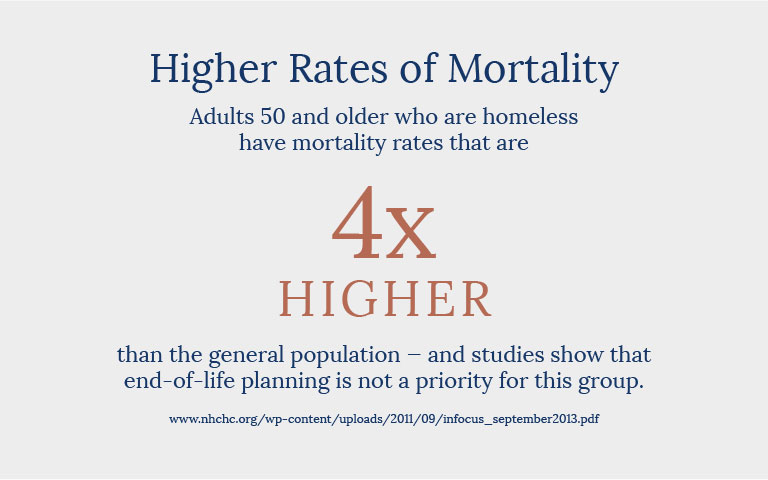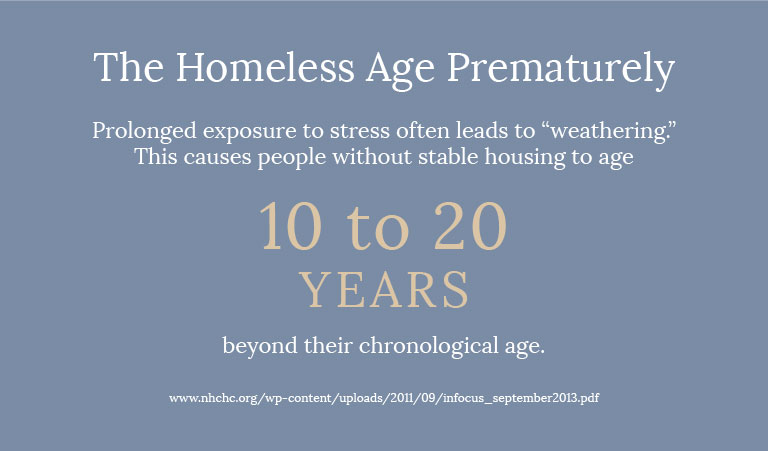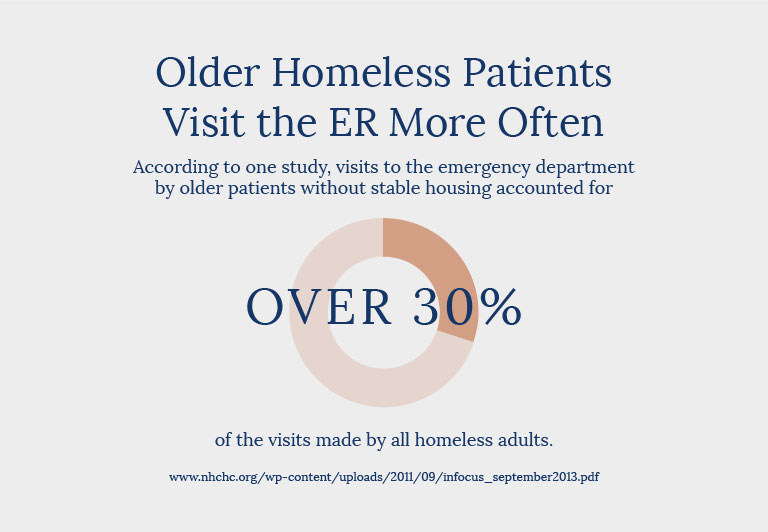Aging on the Streets: America’s Growing Older Homeless Population
The face of American homelessness is changing — into an older one.
People 50 and older make up more than 30 percent of the nation’s homeless population.[i] The advanced age of this country’s homeless requires us to revisit and adapt outdated government assistance programs that were designed to address the needs of a much younger group and fail to account for medical, social, and emotional needs that emerge later in life. [ii] [iii]

The U.S. is facing a graying of the homeless. By 2050, there are expected to be 95,000 elders living without stable housing – which is more than double the current population for this age group.
Source: National Health Care for the Homeless Council
According to the preponderance of research in this area, the growth of elder homelessness can be attributed to the aging of existing chronically homeless individuals and people who experience homelessness for the first time later in life.[iv]
The latter group is emerging from conditions that can be traced back to the 1980s that put increased economic strain on older Americans.[v] These include stagnated wages, disappearing fixed pension plans, and increased housing costs, which hit those relying on fixed incomes especially hard.[vi] More recently, the 2008 economic crisis contributed to the number of elders in the homeless population when large swaths of people between the ages of 50 and 65 either lost equity in their homes or lost their homes to foreclosure.[vii] This pushed many into an unaffordable renting market, which was compounded by the fact that older members of the workforce who lost jobs during the recession were less likely than their younger counterparts to find new ones.

Homeless seniors face higher rates of mortality. Adults 50 and older who are homeless have mortality rates four times higher than the general population – and studies show that end-of-life planning is not a priority for this group.
Source: National Health Care for the Homeless Council
The growing number of older homeless people has altered the most pressing concerns unique and specific to the American homeless population, most notably in the area of health.
While homeless people of all ages suffer from the effects of poor nutrition, limited health care access, and high stress levels, homelessness poses specific health risks for elders.[viii] For example, older populations struggle to manage chronic diseases without the structure a home provides. Those suffering from conditions like diabetes or heart disease are unable to make frequent, necessary visits to doctors or stick to the specific medication regimens and diets vital to maintaining their health.[ix] Additionally, acute stress contributes to premature aging, causing homeless adults older than 50 to experience problems like falls and memory loss at younger ages than those with stable housing.[x]

The homeless age prematurely. Prolonged exposure to stress often leads to “weathering.” This causes people without stable housing to age 10 to 20 years beyond their chronological age.
Source: National Health Care for the Homeless Council
Many older homeless adults turn to institutions such as nursing homes or psychiatric hospitals to get the daily support they need — even though they do not need such intense care. This can lead to what experts call an “institutionalization circuit,” in which older members of the homeless are trapped in a cycle of living on the street and institutionalization.[xi]
Policymakers and social workers can best assist the homeless population by creating, implementing, and supporting programs that target the needs of older individuals.[xii] A great example is Boston’s The Hearth Program, which is a permanent housing program at the forefront of elder homeless care.[xiii] The program offers services that include transportation to medical appointments and housing that is wheelchair accessible. The Hearth model has proven effective in reducing the debilitating costs associated with elder medical care and in decreasing chronic homelessness rates.

Older homeless patients visit the emergency room more often. According to one study, visits to the emergency room by older patients without stable housing accounted for over 30 percent of the visits made by all homeless adults.
Source: National Health Care for the Homeless Council
Designing policies and programs, similar to The Hearth Program, with the medical and accessibility needs of older Americans in mind is vital to ensuring they can age with dignity. Justice in Aging, in partnership with the National Alliance to End Homelessness, released a report earlier this year that outlines a number of solutions that homeless service providers, policymakers, and local governments can support to better serve the aging homeless population.[xiv] Recommendations include:
- An expansion of safety net programs such as Social Security to account for the rise in the cost of living since the programs were created in order to protect seniors who rely on these benefits from falling in to poverty.
- Increased funding for outreach initiatives designed to ensure that populations at risk of homelessness have access to safety net programs.
- An expansion of health care programs like Medicaid and Medicare to include geriatric-specific health needs in order to reduce out-of-pocket medical costs for elders, which, particularly when unexpected medical issues arise, can push those at risk of homelessness over the edge.
- Greater funding for health care providers and community health centers that specifically offer preventive care to homeless elders.
- An increase in the number of affordable housing units available to aging homeless people, as well as housing that is designed to accommodate the specific needs of older occupants.
- Greater focus on creating supportive housing that combines affordable housing with counseling services to address the complex needs of those who are chronically homeless.
- Improved access to low-cost legal services for seniors at risk of losing their housing.
Are you interested in learning more about or advocating on behalf of the homeless population? Read up on the latest news, research and advocacy efforts at:
—
[i] Nagourney, A. “Old and on the Street: The Graying of America’s Homeless,” The New York Times, May 31, 2016. Accessed June 10, 2016. http://www.nytimes.com/2016/05/31/us/americas-aging-homeless-old-and-on-the-street.html?_r=1
[ii] Goldberg, J., Lang, K. & Barrington, V. “How to Prevent and End Homelessness Among Older Adults,” Justice in Aging, April, 2016. Accessed May 20, 2016. http://www.justiceinaging.org/wp-content/uploads/2016/04/Homelessness-Older-Adults.pdf
[iii] Fessler, P. “We Shouldn’t Have to Live Like This,” NPR, March 13, 2013. Accessed May 16, 2016. http://www.npr.org/2013/03/13/173463462/aging-homeless-face-more-health-issues-early-death
[iv] Knopf-Amelung, S. “Aging and Housing Instability: Homelessness Among Older and Elderly Adults,” National Health Care for the Homeless Council, September, 2013. Accessed May 16, 2016. http://www.nhchc.org/wp-content/uploads/2011/09/infocus_september2013.pdf
[v] Goldberg, 2016.
[vi] Knopf-Amelung, 2013.
[vii] Goldberg, 2016.
[viii] Kushel, M. “How the Homeless Population is Changing: It’s Older and Sicker,” The Conversation, January 8, 2016. Accessed May 16, 2016. https://theconversation.com/how-the-homeless-population-is-changing-its-older-and-sicker-50632
[ix] Kushel, 2016.
[x] Knopf-Amelung, 2013.
[xi] Goldberg, 2016.
[xii] Ingrao, C. “Gerontological Social Work: Meeting the Needs of an Aging Population,” SocialWork@Simmons, February 10, 2015. Accessed May 17, 2016. https://socialwork.simmons.edu/gerontological-social-work-meeting-needs-aging-population/
[xiii] Brown, R., Thomas, M., Cutler, D. & Hinderlie M. “Meeting the Housing and Care Needs of Older Homeless Adults: A Permanent Supportive Housing Program Targeting Homeless Elders,” Seniors Housing & Care Journal, 2013. Accessed May 17, 2016. http://www.ncbi.nlm.nih.gov/pmc/articles/PMC3980491/
[xiv] Goldberg, 2016.


